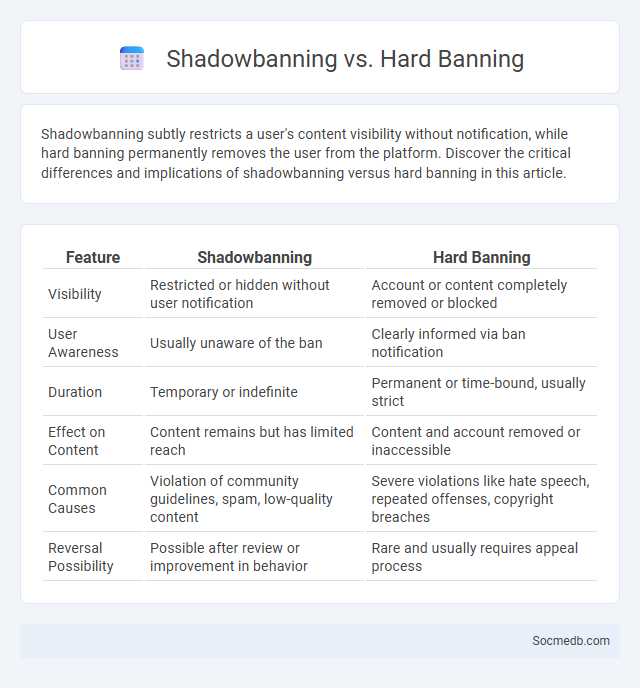
Photo illustration: Shadowbanning vs Hard Banning
Shadowbanning subtly restricts a user's content visibility without notification, while hard banning permanently removes the user from the platform. Discover the critical differences and implications of shadowbanning versus hard banning in this article.
Table of Comparison
| Feature | Shadowbanning | Hard Banning |
|---|---|---|
| Visibility | Restricted or hidden without user notification | Account or content completely removed or blocked |
| User Awareness | Usually unaware of the ban | Clearly informed via ban notification |
| Duration | Temporary or indefinite | Permanent or time-bound, usually strict |
| Effect on Content | Content remains but has limited reach | Content and account removed or inaccessible |
| Common Causes | Violation of community guidelines, spam, low-quality content | Severe violations like hate speech, repeated offenses, copyright breaches |
| Reversal Possibility | Possible after review or improvement in behavior | Rare and usually requires appeal process |
Understanding Shadowbanning: Definition and Purpose
Shadowbanning is a covert moderation technique used by social media platforms to limit the visibility of a user's content without their knowledge, effectively reducing reach and engagement. This practice targets accounts that violate community guidelines or exhibit suspicious behavior to maintain platform integrity and user experience. Understanding shadowbanning helps you identify drops in interaction and adapt your content strategy accordingly.
What is Hard Banning? Key Features and Impact
Hard banning on social media refers to the permanent removal of a user's account due to severe or repeated violations of platform policies. Key features include irreversible suspension, complete loss of access to profile content, and prohibition from creating new accounts using the same identifiers. The impact includes diminished user trust, increased platform safety, and potential shifts in community behavior due to enforcement strictness.
The Basics of Comment Moderation
Effective comment moderation on social media involves setting clear guidelines to ensure respectful and relevant interactions, employing automated filters to detect spam or offensive language, and actively engaging moderators to review flagged content. This approach maintains community standards, fosters positive user experiences, and protects brand reputation from harmful or disruptive comments. Leveraging AI-powered tools alongside human oversight optimizes moderation efficiency and accuracy.
Shadowbanning vs Hard Banning: Spotting the Differences
Shadowbanning involves discreetly limiting a user's visibility without their knowledge, often by reducing post reach or restricting content discovery, whereas hard banning entails outright account suspension or deletion with clear user notification. Detecting shadowbanning requires observing sudden drops in engagement and searchability, while hard banning is immediately evident through user inaccessibility. Platforms like Instagram and Twitter employ these tactics differently to manage policy violations and maintain community standards.
Common Triggers for Each Type of Ban
Social media bans often occur due to specific triggers depending on the platform's policies, such as sharing misinformation, hate speech, or violating copyright rules. Your account may be flagged for repeated spammy behavior, harassment, or posting inappropriate content that breaches community standards. Understanding these common triggers helps you avoid actions that could lead to temporary suspensions or permanent bans.
How Platforms Implement Shadowbans
Social media platforms implement shadowbans by using algorithmic detection systems that identify content violating community guidelines without alerting the user. These systems reduce the visibility of posts by suppressing them in feeds, hashtags, or search results, effectively limiting the user's reach without explicit notification. Machine learning models and content moderation policies work together to enforce shadowbanning, balancing platform safety and user engagement.
User Experience: Shadowban vs Hard Ban
Shadowban limits Your social media visibility by hiding posts and interactions without notification, subtly reducing engagement and reach. Hard Ban immediately blocks Your access, suspending accounts or deleting content due to policy violations, causing a complete cutoff from the platform. Understanding the differences helps optimize Your content strategy to avoid penalties while maintaining user experience and platform presence.
Role of Comment Moderation in Online Communities
Comment moderation plays a crucial role in maintaining a respectful and engaging environment within online communities by filtering out harmful, spammy, or irrelevant content. Effective moderation tools and strategies enhance user experience, promote meaningful discussions, and protect community members from harassment or misinformation. By actively managing comments, you help foster a positive space where diverse voices can participate safely and constructively.
Detection and Appeal Processes for Bans
Social media platforms implement advanced detection algorithms to identify violations of community guidelines, including hate speech, misinformation, and spam. When your content is flagged, you have the right to appeal the ban through a structured review process that evaluates the context and originality of the reported material. Effective appeal procedures ensure fair enforcement while preventing wrongful account suspensions, maintaining platform integrity and user trust.
Best Practices for Users to Avoid Bans and Moderation
Following platform guidelines and community standards is essential to prevent bans and moderation on social media. You should avoid posting offensive content, spamming, or engaging in harassment to maintain a positive online presence. Consistently monitoring content and respecting copyright laws further reduces the risk of account suspension or deletion.
 socmedb.com
socmedb.com